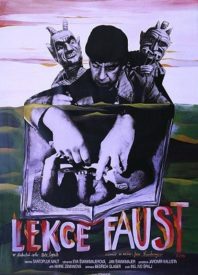
Faust’s story has blazed through the screen, these filmmakers naming titular doctor or through a few other monikers. This 1994 retelling through Jan Svankmejer uses Faust’s actual name but reimagines Goethe’s play as a proto-video game. Two men, Cornelius and Valdes (Jan Kraus and Jirí Suchý), hand out flyers and only one Czech man, the modern Faust (Petr Cepek) pays attention to it. The flyer is actually a map that leads him to a theatre where he finds lumps of clay that turns into babies and eventually, the devil shaping himself to the man’s image. The rest of the film’s 90 minute running time showcase’s Svankmejer’s imagination.
Faust reminds viewers that clay and other practical effects can still transport us. The film also serves as a reintroduction of the Faust story for people who only know the story through retellings. Or, like me, have tried to read both the Goethe and the Marlowe versions and failed. Most retellings focus on Faust’s deal with the Devil, but this adaptation reminds us that he has two paths and just chose the Devil instead. The film then expertly uses jump cuts magically as jump cuts often do. At one point Faust is on top of a rocky hill summoning Mephistopheles through three languages, on another he’s on a snowy field playing with the occult.
The map eventually disappears but Faust is still going from point a to b, from live action to multimedia animation. The film does a mostly successful job at immersing its viewers to its reality, which is half real and half demonic. And the intentions behind those juxtapositions are clear – he might have left hell but the demons still follow. But those switches can be occasionally distracting. There are times when I just want to stay in the underworld and let that world sink it. Also, how many dank backrooms of storefronts does this film have to show to express its sense of dread?
The devil, as I wrote earlier, follows Faust wherever he goes. The film spends a considerable amount in its third act in his fourth (?) destination, which happens to be Portugal. There, both the devil and the Portuguese royal court appear as puppets. Here, the King asks for an introduction to David and Goliath, and Faust does his best to comply. The film basically tells the same lessons that other retellings do, asking viewers the rhetorical question of whether or not devilish shortcuts work. But this adaptation, despite its flaws, have an erudite and textural feel making it worth watching.
Watch Faust, coming soon on OVID.

